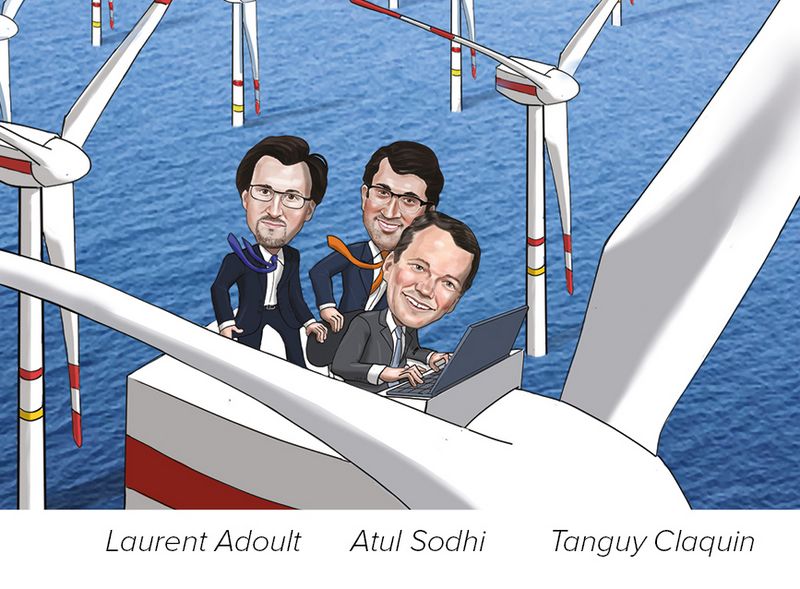Across the spectrum
For its raft of landmark bond, loan and convertible ESG deals, as well as a host of ESG framework updates, particularly alignments with the demanding EU Taxonomy for sustainable activities, Credit Agricole CIB is IFR’s EMEA ESG Financing House of the Year.
![]()
Across the broadest spectrum – all the way from Europe’s first digital green bond to real asset financings via sustainable supply chain finance and local SME deals – Credit Agricole CIB remained a dominant presence in European ESG finance in 2023.
“The bank has been very strong in ESG debt capital markets for the longest time. The question is how to stay ahead,” said Atul Sodhi, global head of DCM.
His answer: “Bringing value into the chain”.
Tanguy Claquin, head of sustainable banking, also pointed to the bank’s continuing commitment to its now very rare ESG syndicate and ESG legal roles. These bring it market intelligence and help it address legal risk in ESG financing, he said.
One high-profile illustration of CACIB’s capacities was the digital green bond that the bank sold for the European Investment Bank in June.
The SKr1bn (US$93m) two-year bond not only marked Europe’s first next-generation green offering (and one of the world’s first) but was registered and settled via so|bond – a blockchain platform that aims to be both far greener in its energy consumption than other distributed ledger technologies and also accessible to all market players as a non-proprietary open-source platform. This contrasts with the closed DLT platforms that a number of banks have developed for their digital deals.
“It’s a perfect mix of different innovation features,” said Eric Busnel, deputy head of SSA DCM.
Sweden’s SEB was also a joint bookrunner on the deal, which was targeted to Swedish institutional buyers. CACIB and SEB developed the so|bond platform jointly.
The bank’s work in renewable energy and green hydrogen lending also stood out. This included some £2bn of debt finance for the Moray West offshore wind farm in the UK, as well as an advisory mandate for a similar project off the coast of Normandy.
“We finance every piece needed for transition,” said Laurent Adoult, head of sustainable banking, FI/SSA Europe, citing no fewer than 57 categories in the bank’s own green bond framework – including transportation of offshore wind turbines to their locations at sea.
Besides EIB, other standout deals in the SSA sector included the year’s largest sovereign green bond – a €10bn six-year for Italy under a framework for which CACIB was structuring adviser.
Deal flow for financial names featured an inaugural €500m Tier 2 sustainability bond for CNP Assurances after it added social categories to its green bond framework.
The bank was also green structuring adviser for a €600m inaugural green senior non-preferred bond from Belgian cooperative bank Crelan, as well as €400m in the same format for Italy’s Credito Emiliano.
In the corporate sector, sustainability-linked loans, where CACIB was the leading structuring agent globally by far, remained an important part of its franchise. Highlights included the real estate sector’s first SLL to incorporate revenue aligned for the European Union’s Taxonomy of sustainable activities as a key performance indicator – a €200m revolving credit facility refinancing for French developer Altarea.
Other notable mandates were advising a European catering company and a leading agricultural commodity firm on innovative KPIs on food waste and deforestation/supply chain traceability, respectively, in SLLs of €200m and an undisclosed size.
A further facet of CACIB's corporate ESG financing over the year was structuring only the third convertible sustainability-linked bond yet closed – a €400m for engineering firm Spie.
CACIB also managed groundbreaking ESG financings for small and medium-sized enterprises in its home market. These included the Science Based Targets initiative’s forest, land and agriculture guidance in an SME SLL for the first time – French food producer Panzani’s €340m/€60m term loan B and revolving credit facility.
In addition, it undertook multiple assignments to help leading bond issuers align their green and sustainable financing frameworks with the EU taxonomy. Despite CACIB not being a primary dealer in Hungarian government bonds, the sovereign’s debt office – the key green bond issuer in Central and Eastern Europe – mandated the bank to rework its framework to achieve alignment for renewable energy and some energy efficiency investments.
Similarly, CACIB spent months helping Bpifrance achieve alignment for its renewable energy loans and a portion of its loans for green buildings, and completed a similar assignment for La Banque Postale.
In addition, it was joint structuring adviser on Gasunie’s green financing framework – one of the first to be aligned with the EU’s new Green Bond Standard – and played a similar role for Norwegian fertiliser company Yara, whose deal was the first with a green ammonia category.
To see the digital version of this report, please click here
To purchase printed copies or a PDF of this report, please email shahid.hamid@lseg.com in Asia Pacific & Middle East and leonie.welss@lseg.com for Europe & Americas.










